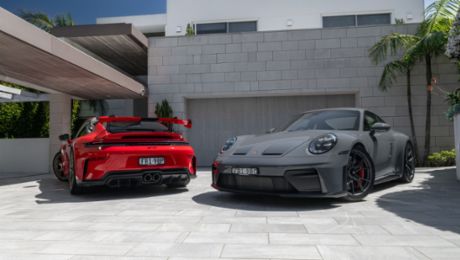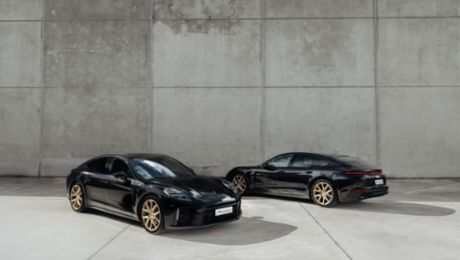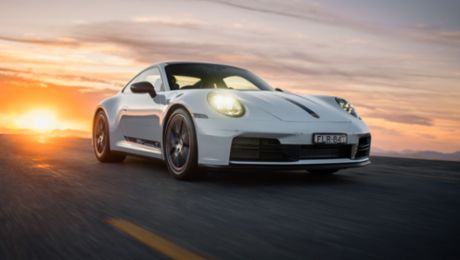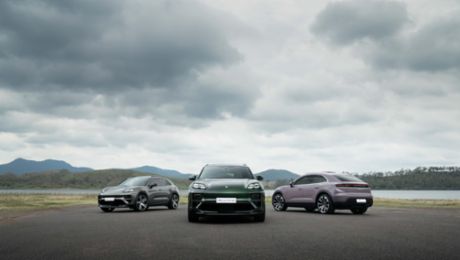Product concept
Porsche has crowned the 718 mid-engine model line with the new 718 Spyder RS, a sports car designed for maximum driving pleasure.
The 718 Spyder RS is the open-top counterpart to the 718 Cayman GT4 RS.
Model positioning: The 718 Spyder RS is the leader of the Porsche 718 model range.
The RS name at Porsche
The RS model designation at Porsche refers to RennSport, or ‘racing sport’.
Porsche sports cars assigned the RS name are either road-legal models that have been derived from their motor racing equivalent, or distinctly sporty in nature.
The first Porsche model to use the RS name was the famed 718 RSK racer of 1957.

Australian model series
The introduction of the new 718 Spyder RS brings the Australian-market Porsche 718 model range to 10 variants:
- 718 Cayman
- 718 Boxster
- 718 Cayman Style Edition
- 718 Boxster Style Edition
- 718 Cayman S
- 718 Boxster S
- 718 Cayman GTS 4.0
- 718 Boxster GTS 4.0
- 718 Cayman GT4 RS
- 718 Spyder RS
lo.jpg/jcr:content/DSC05207%20(1)lo.jpg)
“The 718 Spyder RS raises driving pleasure to a new level for open-top vehicles. The combination of our unmistakable GT3 engine, the close-ratio transmission, compact dimensions, low weight, road-optimised racing suspension and maximum openness offers an extremely compelling and unfiltered driving experience.” Andreas Preuninger, Director GT Cars
Engine: twin-turbocharged performance
The new 718 Spyder RS is fitted with the same engine used in the 911 GT3. It is mid-mounted, which means it is located between the seats and the rear axle.
The engine in the 718 Spyder RS is a 4.0-litre (3,996 cc) naturally aspirated (non-turbocharged) boxer engine.
Maximum power output is 368 kW (500 PS*) at 8,400 rpm.
Maximum torque is 450 Nm of torque at 6,750 rpm.
Maximum engine speed is 9,000 rpm.
A combination of motorsport-derived engine technologies have been applied to the high-revving engine in the 718 Spyder RS.
A rigid valve drive actuate the engine’s 24 valves. They use no hydraulic valve clearance compensation to ensure robust performance and optimal gas flow at even the highest engine speeds.
VarioCam technology ensures camshaft control is adjusted precisely to the engine speed and load conditions.
Each of the engine’s six cylinders uses an individual throttle body at the end of the variable-resonance intake system.
Each throttle body is in close proximity to its corresponding intake valves to ensure precise fuel and air delivery. This also results in excellent engine response because there is hardly any air volume between the throttle valve and the intake valve, giving drivers precise responsiveness from the accelerator pedal when pressing down or lifting off.
There is a central throttle valve fitted as a backup solution, but is permanently open during normal engine operation.
Dry sump lubrication with a separate engine oil tank ensures correct oil supply to the high-revving engine, especially during higher-speed cornering.
The dry sump lubrication has seven suction stages. The system’s design routes engine oil back into the external reservoir quickly and efficiently. The oil pump through the crankshaft directly lubricates the heavily loaded connecting-rod bearings.
Two intake channels integrated into the body behind the roll-over bars provide the engine with intake air. These channels correspond to the intake ports fitted in the fixed rear windows of the 718 Cayman GT4 RS.
These two air-intake channels direct incoming air into a central airbox located behind the seats and below the rear lid, providing optimal air supply to the engine even when maximum power is demanded.
Both the driver and passenger can enjoy the six-cylinder engine’s intake sound whether the roof top is open or closed.
Adding to the soundtrack is the lightweight stainless steel sports exhaust system, which features two separate gasoline particulate filters (GPFs) as well as a stereo Lambda control circuit for both catalytic converters. Together, they carry out the all-important emission-control functions.
The new 718 Spyder RS delivers the same engine outputs as its model range sibling, the 718 Cayman GT4 RS. This means both cars are the most powerful offerings in the Porsche mid-engined family.
With the new 718 Spyder RS, Porsche is now entering the final straight for midengined sports cars with naturally aspirated engines. This means the 718 Spyder RS stands as the crowning achievement of the model line in terms of open-topped driving pleasure.

Transmission: Seven-speed PDK
The 718 Spyder RS uses a real-wheel drive layout like all other Porsche models in the 718 range.
Like all modern Porsche RS models, the new 718 Spyder RS is fitted exclusively with the Porsche dual-clutch transmission (PDK). PDK stands for Porsche Doppelkupplung, (‘Doppelkupplung’ is German for ‘double coupling’, denoting the gearbox’s double-clutch coupling design.)
The key advantage of the PDK gearbox is it delivers millisecond-fast gear changes for uninterrupted acceleration.
The PDK gearbox in the 718 Spyder RS is fitted with seven short-ratio gears for strong acceleration.
When driving in PDK Sport mode, downshifting during braking is more rapid. When accelerating, the upshifts occur at higher engine speeds.
Drivers can choose to change gears manually using the steering wheel-mounted gear-change paddles. The right paddle is used for upshifting, the left paddle for downshifting.
Drivers can also use the centre console-mounted gated gearshift lever for manual gear-changing. Drivers can simply pull to shift up, and push to shift down, just like in motorsport. The shift lever is the same used in the current-model 911 GT3.
An electronically controlled rear differential lock with fully variable torque distribution is fitted and uses RS-specific locking values (traction 30 per cent/overrun 37 per cent). It helps deliver maximum drive to the rear wheels when accelerating.
Porsche Torque Vectoring (PTV) works with the Porsche Stability Management (PSM) system to optimise drive-torque distribution to the rear wheels. This is especially important on road surfaces with varying traction levels.

Chassis and suspension: Precise control
The 718 Spyder RS uses the same suspension components as the 718 Cayman GT4 RS, which took its development inspiration from the motor racing world.
The engineers at Porsche developed the 718 Spyder RS to deliver maximum driving pleasure on winding roads. The priority was on exceptional driveability and maximum steering precision that gives the driver a high degree of feedback for a high level of confidence.
The front axle of the 718 Spyder RS is largely the same as that used in the 911 GT3 RS (generation 991.2).
The classic MacPherson strut-type axle is additionally equipped with helper springs. These keep the main suspension springs under tension when they are deflected. The main spring maintains its original tension even under maximum suspension load, optimising vehicle controllability during dynamic driving manoeuvres.
Ball joint suspension connections to the chassis create tight connections for precise and direct handling.
The 718 Spyder RS has been lowered 30 mm compared to the 718 Boxster.
Compared to the 718 Spyder, the front track width is seven millimetres wider and the rear track eight millimetres wider. Rear axle camber has been increased one-quarter of a degree to help the tyres transfer more cornering forces, making cornering even more predictable.
The damper rates in the 718 Cayman GT4 RS have been designed for the best possible lap times on a closed racing circuit. The damper rates in the 718 Spyder RS have been reduced to allow the car to adapt to different road conditions to give drivers precise and predictable handling on varying road conditions. Even with these tuning settings, the 718 Spyder RS remains fundamentally ready for the track.
In the 718 Spyder RS, the ride height, track, camber and anti-roll bars can be individually adjusted to suit the driver's preferences and the characteristics of the route.
Porsche Active Suspension Management (PASM) and sports tuning are fitted to the 718 Spyder RS.
In Normal mode, the PASM-controlled dampers prioritise ride comfort. They automatically switch to a more sporting tune as soon as the car is driven more dynamically. When in Sport mode (which can also be manually activated by the driver), the ride is firmed for optimal agility and better track-driving performance.
Three electronic control systems at the heart of the Porsche Stability Management (PSM) system – anti-lock braking (ABS), Electronic Stability Control (ESC) and Traction Control (TC) – intervene sensitively when the 718 Spyder RS is close to the limit of driving performance. Porsche has set up the chassis so that it combines the best possible performance with safe handling even without the use of electronic control systems.
Porsche Torque Vectoring (PTV) applies electronically controlled brake interventions on the rear wheels to enhance driving dynamics when needed. The inside rear wheels is braked slightly with additional drive torque applied to the outside wheel. The result is an extra steering effect for quicker cornering performance.
A front axle lift system is optionally available. This hydraulic function is operated at the press of a button on the centre console and lifts the front of the 718 Spyder RS by 30 mm, giving 40 mm of ground clearance at the front spoiler lip to assist with navigating speed humps and car park entrances. The system operates when stationary and at speeds up to 60 km/h.
Electromechanical power steering is fitted to the 718 Spyder RS. It has a variable steering ratio and speed-dependent steering assistance.

Brakes
The details of the high-performance braking system fitted to the 718 Spyder RS are:
Front brakes:
- 408 mm diameter (36 mm thick) internally ventilated and countersunk composite brake discs with Aluminium brake chambers
- Six-piston aluminium monobloc fixed brake calipers
Rear brakes:
- 380 mm diameter (30 mm thick) internally ventilated and countersunk composite brake discs with Aluminium brake chambers
- Four-piston aluminium monobloc fixed brake calipers
The brake calipers on the 718 Spyder RS are Red in colour.
An electric parking brake is also fitted as standard equipment.

Wheels and tyres
The 20-inch wheels fitted to the 718 Spyder RS are made from forged Aluminium, delivering an impressive balance of strength and low weight.
They are painted Dark Silver. The central wheel bolts are Black in colour and the hub covers wear the Porsche ‘RS’ lettering in silver.
The wheel and tyre dimensions are:
- Front: 8.5J x 20 ET 61 with 245/35 ZR20 tyres
- Rear: 10.5J x 20 ET 50 with 295/30 ZR20 tyres
Tyre Pressure Monitoring (TPM) with Track mode is also fitted. This systems notifies the driver of gradual or sudden loss of tyre pressure. It also considers pressure and temperature for racetrack use.
lo.jpg/jcr:content/DSC06013-Edit%20(1)lo.jpg)
Body and aerodynamics
The 718 Spyder RS visually communicates its high-performance abilities using various exterior design cues.
The ducktail-style rear spoiler is a Porsche RS signature, first used in the iconic 911 famous 911 Carrera RS 2.7 of 1972.
The adjustable wings used on the 718 Cayman GT4 RS are not used on the 718 Spyder RS. This is because aerodynamic development in a sports car without a fixed roof is less about optimal downforce and more about driving stability and balance in all conditions.
When the optional Weissach Package (see separate section further down) is specified, an extra Gurney flap is fitted to the rear spoiler.
Balancing the aerodynamically optimised rear is the front lip of the 718 Spyder RS. Compared to the 718 Cayman GT4 RS, it’s shorter.
Other than the changed front lip, the front end of the 718 Spyder RS is identical to the 718 Cayman GT4 RS.
Wheel arch vents on top of the front wings reduce excess air pressure inside the wheel arches at higher speeds. This pressure is generated by the high-speed rotation of the wheels. These vents help prevent aerodynamic lift at the front axle.
Two NACA ducts fitted to the lightweight bonnet improve brake cooling without impairing aerodynamic drag, two properties that are usually mutually exclusive.
NACA ducts were first developed by the National Advisory Committee for Aeronautics (NACA) in the USA — the predecessor of the NASA space agency.
There is a central air opening in the front bumper just in front of the carbon fibre reinforced plastic (CFRP) bonnet through which air is channeled out of the car.
Air is guided around the front wheels via the side blades in the front apron.
Underneath the 718 Spyder RS, new deflectors on the fully clad underbody channel air under the car. This creates a vacuum at the rear, reducing aerodynamic lift at the rear axle.
Two extra NACA ducts in the car’s underbody direct cooling towards the gasoline particulate filter without any impact on the overall drag coefficient.
An improved rear aerodynamic diffuser is fitted with side fins to add extra airflow stability at the rear of the car and improve grip.

Lightweight design
The engineers at Porsche focused on achieving a lightweight design for the 718 Spyder RS.
The 718 Spyder RS weight 1,410 kilograms (90 per cent full tank without a driver, measured to DIN standards.)
Each one of the engine’s 500 PS* is responsible for accelerating just 2.82 kg (3.83 kg/kW).
Various measures were taken to achieve this light weight design:
- The bonnet and both front wings are made from carbon fibre reinforced plastic (CFRP).
- Specific insulation materials were omitted from the design.
- Lightweight carpets are used in the interior.
- Lightweight door panel trims with textile opener loops and nets for storage compartments – signature Porsche RS features – are also used.
- The lightweight top (hood) uses a number of weight-saving measures, such as a single fabric layer and manual operation.
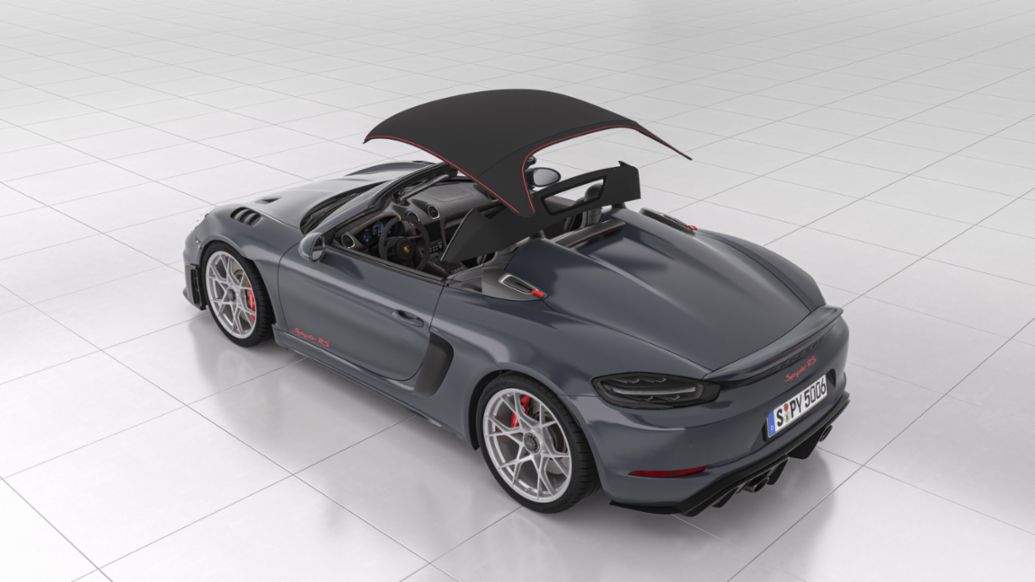
The manually operated hood comprises two parts: a ‘sunshield’ (also referred to as a sun sail) and a weather guard. Both are removable and can be stored in the car together or singly.
The sunshield can be used as a ‘bimini’ top, protecting the occupants from sunlight but keeping the passenger compartment open at the sides and rear.
The weather guard has a glass rear window can be fitted for protection against rain.
The total weight of the entire roof (including all mechanical parts) is just 18.3 kilograms, 16.5 kilogram less than in the 718 Boxster.
In its lightest configuration, the Porsche 718 Spyder RS weighs 40 kilograms less than the previous 718 Spyder with PDK.
Further weight savings are available when the optional Weissach Package is fitted (see section below).
The 718 Spyder RS is available in four Standard Colours and six Special Colours, including Vanadium Grey Metallic, a new colour developed specifically for the 718 Spyder RS.
Porsche Exclusive Manufaktur also offers more than 110 pre-approved Paint to Sample exterior colours.
The Black soft top comes standard entirely coloured in Black but can be specified with either Arctic Grey highlights or Carmine Red highlights.
Driving performance
The impressive power-to-weight ratio of the 718 Spyder RS gives it remarkable driving performance.
The 718 Spyder RS is the fastest soft-top 718 Porsche of all time.
0 – 100 km/h: 3.4 seconds.
0 – 200 km/h: 10.9 seconds (on a suitable closed racing circuit).
Top speed: 308 km/h (on a suitable closed racing circuit; without the roof fitted).

Optional Weissach Package
The optional Weissach Package equips the 718 Spyder RS with the following special items:
- 20-inch forged magnesium wheels are 10 kilograms lighter compared to the standard wheels
- Carbon fibre reinforced plastic (CFRP) is used in the construction of the front luggage compartment lid, the process air intakes, the cooling air intakes, the upper shells of the exterior rear vision mirrors, the central brake light in the rear engine cover, the rollover bars and on the ducktail’s Gurney flap
- The exhaust tailpipe trims are made of Titanium in the same style as the Porsche 935
- The ‘Weissach Package’ logo is embroidered into the convertible top
- The upper section of the interior dashboard is trimmed in Race-Tex material
- The seat head rests are embroidered with the ‘Weissach Package’ logo
- There is a ‘Weissach package’ badge on the cup holder

Interior
The two-seat 718 Spyder RS is a driving machine for the purist, which is why the interior has been reduced to the essentials.
The full bucket seats – a feature in all Porsche RS models – were first used in the Porsche 918 Spyder. They are made from Carbon Fibre Reinforced Plastic (CFRP) with a carbon-weave finish. They are a lightweight design and have been optimised for lateral support.
18-way electrically adjustable Adaptive sports seats are available as an option. These are upholstered in Black leather with the seat centres trimmed in Black Race-Tex. The head rests are embroidered with a black Spyder RS logo.
The RS sports steering wheel (360 millimetre diameter) is adjustable for rake (angle) and reach (distance from the driver’s body) and is trimmed in Race-Tex. Its yellow top-centre marker indicates to the driver how far the steering wheels are turned, which is helpful during high-performance oriented driving.
The PDK gearbox lever in the centre console resembles the look of a manual gear lever.
The door sill guards are finished in a satin carbon-weave and carry the model designation 'Spyder RS' in Silver.
Satin carbon-finish is also applied to the dashboard trim strips and centre console trim.
The interior of the 718 Spyder RS is upholstered in a mix of Black leather and Black Race-Tex.
Black leather:
- Seat bolsters
- Headrests
- Steering wheel airbag module
- Side parts of door panel armrest
- Side panels of centre console storage compartment lid
Black Race-Tex:
- Steering wheel rim
- Selector gaiter
- PDK selector lever grip area
- Interior door handles
- Door panel armrest
- Centre console storage compartment lid armrest
- A-pillars
Porsche Communication Management (PCM) and assistance systems
The 718 Spyder RS is equipped with the Porsche Communication Management (PCM) system, which includes:
- Online Navigation, smartphone integration and audio interfaces.
- Porsche Connect Plus with Apple® CarPlay (wired), Wi-Fi hotspot, LTE telephone module with SIM card reader, and a wide range of other Porsche Connect services.**
- Digital radio (DAB+)
- Sound Package Plus, comprising six speakers, an integrated amplifier, digital sound processing and 110 Watts of total output.
USB and AUX-IN interfaces are fitted to the glove compartment.
12-volt sockets are fitted in the passenger footwell and centre console storage compartment.
A fully active BOSE® surround sound system is optionally available at no-cost. It consists of 10 loudspeakers, including centre speaker and active subwoofer integrated into the vehicle body; total output is 505 Watts.
If desired, the Communication and Audio systems can be deleted from the car. Centre console storage is used in the instrument panel in place of the Communication and Audio hardware. The AUX-IN and USB interfaces are also deleted if this option is chosen.
Rear ParkAssist with reversing camera provide audible and visual signals to the driver when maneuvering the 718 Spyder RS, making parking easier, especially when navigating tight spots.
The cruise control system makes highway driving simpler.
lo.jpg/jcr:content/DSC04741%20(1)lo.jpg)
Exclusive Porsche Design Chronograph
An exclusive matching Porsche Design chronograph watch is offered to buyers of the 718 Spyder RS and Spyder RS with the Weissach Package.
Called the Chronograph 718 Spyder RS, it is an exquisite piece if craftsmanship and is made to exacting standards of precision at Porsche’s in-house watchmaking operation in Solothurn, Switzerland.
It features a 01.200 movement with COSC certification.
This special timepiece is exclusively for customers of the new Porsche 718 Spyder RS.
It uses a Titanium case to match the characteristic lightweight design of the 718 Spyder RS.
This Porsche Design chronograph echoes the configurability of the 718 Spyder RS by offering buys the choice of either natural Titanium or Black Titanium for the appearance of the case.
A matching bezel featuring either a minute hand or tachymeter scale is also fitted.
The band is available in either smooth Black vehicle leather with a Race-Tex accent, or in Titanium. The dial is available in carbon or black.
The hands are available in white, black or yellow.
On the back, the Chronograph 718 Spyder RS features a rotor design that echoes the wheels installed on the respective car. The rotors themselves can be ordered in six different colours, while the individual colour ring around the dial can be in any of the colours available for the Porsche 718 Spyder RS – whether standard, metallic or special colours.
The 114 colours of the Porsche Paint to Sample programme are also available for the watch, letting owners create a truly one-off timepiece.
Buyers can also have up to 12 characters engraved into the back of the watch, such as the VIN number of their own 718 Spyder RS.

By the numbers
3,996 cc flat 6-cylinder naturally-aspirated petrol engine
368 kW / 500 PS* at 8,400 rpm
450 Nm at 6,750 rpm
9,000 rpm maximum engine speed
7-speed Porsche Doppelkupplung (PDK) transmission; rear-wheel drive
30 mm lower ride height
1,410 kg unladen weight
0 – 100 km/h 3.4 seconds
0 – 200 km/h 10.9 seconds (on a suitable closed racing circuit)
308 km/h top speed (on a suitable closed racing circuit; without the roof fitted)
In summary
The 718 Spyder RS is the crown of the Porsche mid-engine 718 sports car family and has been designed for maximum driving pleasure.
Driving dynamics
- Porsche Torque Vectoring (PTV) including mechanically locking rear differential
- Porsche Active Suspension Management (PASM) variable damper system with sports setup and ride height lowered by 30 mm
- Porsche Stability Management (PSM) including ABS anti-lock braking with two switchable stages (ESC OFF and ESC+TC OFF)
Audio and communication
- Porsche Communication Management (PCM) including Online Navigation, mobile phone preparation and audio interfaces
- Porsche Connect** services with Apple® CarPlay (wired) and Wi-Fi hotspot
- 110-Watt Sound Package Plus sound system
Australian standard specifications
- Automatically dimming mirrors with integrated rain sensor for windscreen wipers
- Cruise control
- DAB+ digital radio
- Rear ParkAssist with reversing camera
- Light Design Package
- Tyre fit set
- Windscreen with Grey top tint
- LED headlights including Porsche Dynamic Light System (PDLS)
- BOSE Surround Sound System (as a no-cost option)
Warranty and service pricing
- 3-year / unlimited kilometre warranty
- 1-year / 20,000-kilometre service intervals
- Service pricing varies from state to state due to different workshop .labour rates at Official Porsche Centres. For an indication of service pricing please visit the website of your nearest Official Porsche Centre.
Info
More information for consumers: here.
More information for media: here or contact press@porsche.com.au
* PS (Pferdestärke, German for horsepower) is the standard unit used in the European Union to measure the power output of a motor in ‘metric horsepower’
# The published consumption (l/100km and Wh/km), emissions (g/km) and kilometre (km) range figures are determined by Porsche AG testing in accordance with ADR 81/02 on test vehicles. Actual figures will vary as they are dependent on many factors, including without limitation: individual driving style, road and traffic conditions, environmental conditions, fuel quality, a vehicle’s or battery’s condition, load and use. Extra features and accessories (eg: equipment, wheels or tyres used etc.) can change relevant vehicle parameters such as weight, rolling resistance and aerodynamics and can also affect the consumption, emission, range and performance values of a vehicle. CO₂ emissions can also be generated at the power source when vehicles are being recharged, unless 100% renewable energy is used. Generally, consumption, emissions, kilometre range and charging times will vary from the published figures in real world Australian driving and charging conditions.
Apple®, Apple CarPlay® and Siri® are registered trademarks of Apple Inc.
** The availability of Porsche Connect services is dependent on the availability of wireless network coverage which may not be available in all areas, and may be subject to eventual technology sunset or deactivation, thus nullifying services. The vehicle equipment necessary to use Porsche Connect is only available factory-installed, and cannot be retrofitted. Some functions may require separate subscriptions, or data charges may apply. **Porsche Connect includes a free subscription period of 36 months. An integrated LTE-enabled SIM card with data allowance for use of selected Porsche Connect services will be included. For further information on free subscription periods, follow-on costs and availability of individual services in your country, please visit www.porsche.com/connect or consult your official Porsche Centre.
lo.jpg/jcr:content/DSC06335-Edit%20(2)lo.jpg)
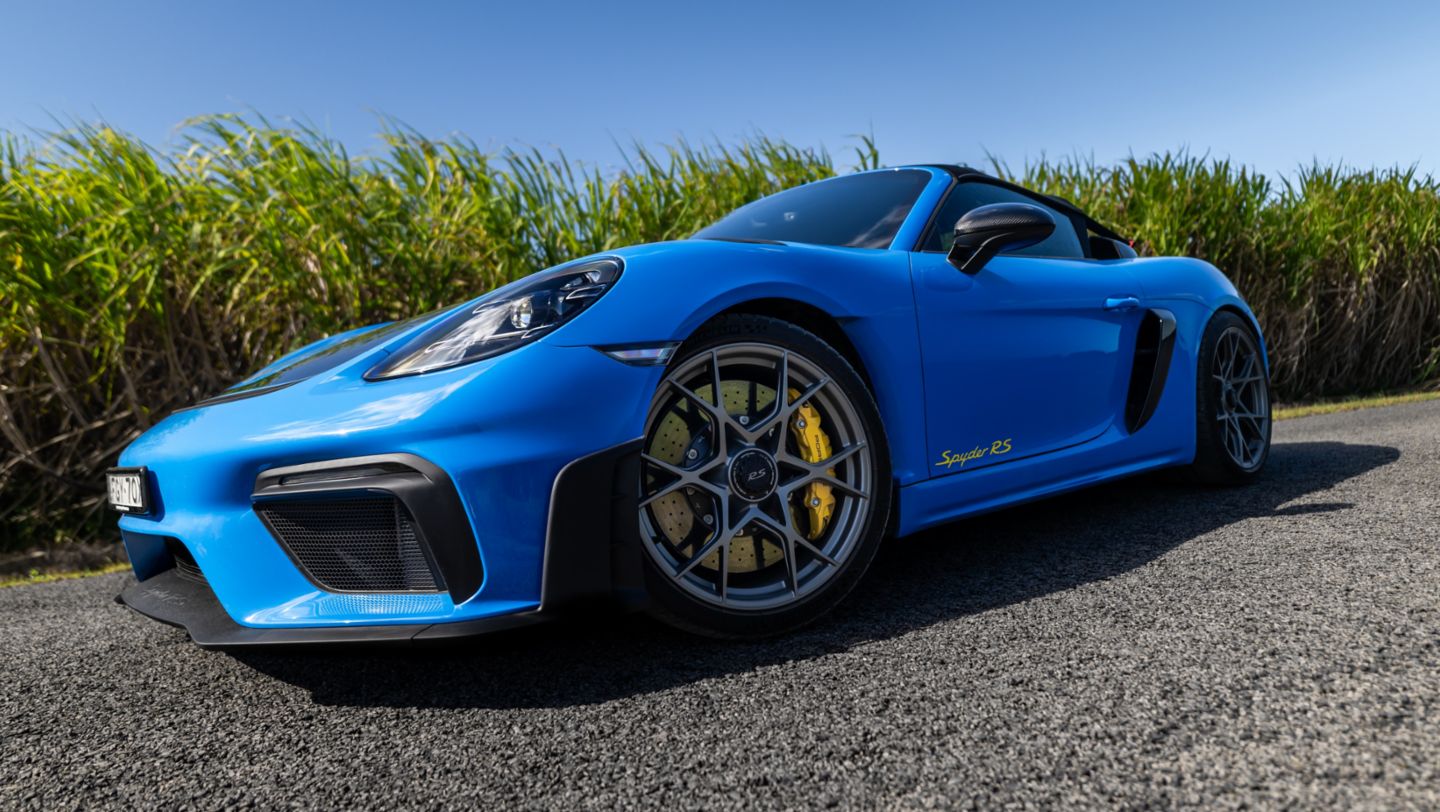
lo.jpg/jcr:content/DSC05693-Edit%20(1)lo.jpg)
lo.jpg/jcr:content/DSC05365%20(1)lo.jpg)
lo.jpg/jcr:content/DSC04850%20(1)lo.jpg)
lo.jpg/jcr:content/DSC05600%20(1)lo.jpg)
lo.jpg/jcr:content/DSC05546%20(1)lo.jpg)
lo.jpg/jcr:content/DSC04680%20(1)lo.jpg)
